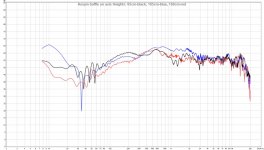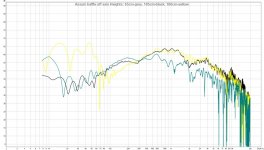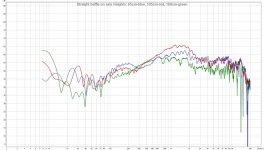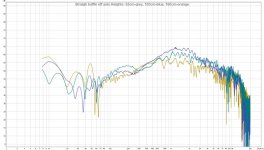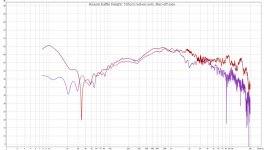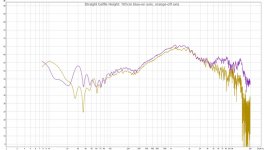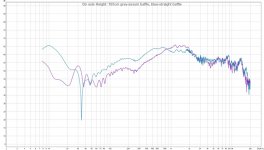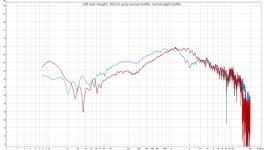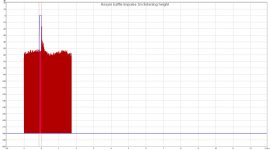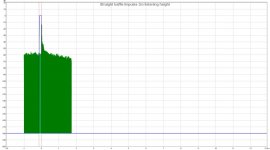Hi there,
I've been a member in this forum for a while, but have not posted anything so far until now. So it's a bit of introducing myself as well, I guess.
Doing this with a friend of mine, we now have a prototype of an open baffle line array up and going. Inspired by speakers like Adyton's Imagic Imagic 2.0 Loudspeakers , Steinway-Lyngdorfs Concertos, and many great builds going on here (Wesayso's array, Halair's, loads of OB's: StigErik, Scorpion, The Fin etc) the goal was set to try to make an active OB line array. A sort of "Dipole Imagic".
Enough said, here are the specs/goal for the final set up:
3-way active Line array
OB/Dipole
16 Vifa TC9 (Vifa9 BN 119/8) in each speaker
Mundorf AMT dipole tweeter
OB/Ripole sub (2x12" each)
2 x Hypex as2.100d
Rough estimation of cross overs: Vifas running down to about 100-200Hz up to 4000Hz where comb filtering will start (These are 84mm cc). If the combing can be eq'ed out (which it might not?) we can leave them as they are maybe...?
So far we have a prototype running with the Vifa's, having the aim to set the midrange first.
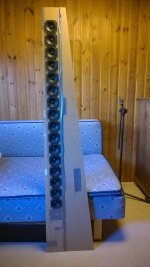
I've been studying Jim Griffin's and M J King's white paper's, some Linkwitz and other ob sites (+loads of forum threads...), so I'm a bit aware what we're up aginst! We did a 180x11cm baffle to mount the Vifa's in with piano hinges on the sides, then put different baffle sizes and shapes to it and listened to how these affect this array quite differently. Anything from a angled back v-frame with 45cm wings, to the single naked mounting baffle have been tested. (Please ask if you are interested i some special shape.) According to both Edge and my ears the versions with any kind of angles baffle shapes (more like a pyramid) always got the best result. Finally we have set for a flat baffle, having the array off center and angle the baffle side shapes:
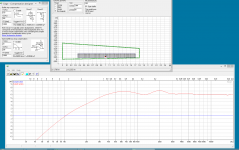
Having the array centered or having completely rectangular baffles gave a more "dead" sound presentation (if I may be subjective here;-)) and didn't improve soundstaging. I should also mention that the array is power tapered in a 2/4/4/6 way (but will probably be 2/3/3/4/4 because I think it's too much now).
So please now, have a look at these measurements. Made outdoors, 1,2,3 meters resp. with REW and UMIK-1.
All distances:
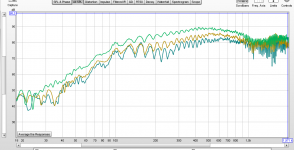
3m complete:
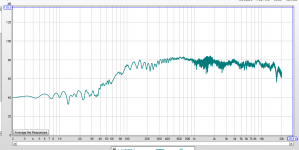
3m zoom in:
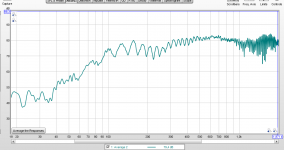
Thing is, while there is no problem to get some bass in the array despite it's an OB (according to our xover goal), the midrange where the array should excel is very strange. Some voices, double bass, flutes, some westcoast jazz can sound quite good, while strings, acoustic piano is cathastrophy: hollow, "distorted", sharp, i.e. no body to it. So far my limited knowledge of EQ/filters cannot solve this. I've tried briefly but this tendency remains whatsoever.
Now I'm finally coming to the point where are now, because all this tapering and assymetric shapes in an OB maybe are the cause of my current problems? Or shouldn't it help? Are there too many therories competeing in the same speaker?
Please help, because probably I'm missing out of something fundamental here!
Any input appreciated!
Best wishes,
Anders
PS Hope the image upload worked!
I've been a member in this forum for a while, but have not posted anything so far until now. So it's a bit of introducing myself as well, I guess.
Doing this with a friend of mine, we now have a prototype of an open baffle line array up and going. Inspired by speakers like Adyton's Imagic Imagic 2.0 Loudspeakers , Steinway-Lyngdorfs Concertos, and many great builds going on here (Wesayso's array, Halair's, loads of OB's: StigErik, Scorpion, The Fin etc) the goal was set to try to make an active OB line array. A sort of "Dipole Imagic".
Enough said, here are the specs/goal for the final set up:
3-way active Line array
OB/Dipole
16 Vifa TC9 (Vifa9 BN 119/8) in each speaker
Mundorf AMT dipole tweeter
OB/Ripole sub (2x12" each)
2 x Hypex as2.100d
Rough estimation of cross overs: Vifas running down to about 100-200Hz up to 4000Hz where comb filtering will start (These are 84mm cc). If the combing can be eq'ed out (which it might not?) we can leave them as they are maybe...?
So far we have a prototype running with the Vifa's, having the aim to set the midrange first.

I've been studying Jim Griffin's and M J King's white paper's, some Linkwitz and other ob sites (+loads of forum threads...), so I'm a bit aware what we're up aginst! We did a 180x11cm baffle to mount the Vifa's in with piano hinges on the sides, then put different baffle sizes and shapes to it and listened to how these affect this array quite differently. Anything from a angled back v-frame with 45cm wings, to the single naked mounting baffle have been tested. (Please ask if you are interested i some special shape.) According to both Edge and my ears the versions with any kind of angles baffle shapes (more like a pyramid) always got the best result. Finally we have set for a flat baffle, having the array off center and angle the baffle side shapes:

Having the array centered or having completely rectangular baffles gave a more "dead" sound presentation (if I may be subjective here;-)) and didn't improve soundstaging. I should also mention that the array is power tapered in a 2/4/4/6 way (but will probably be 2/3/3/4/4 because I think it's too much now).
So please now, have a look at these measurements. Made outdoors, 1,2,3 meters resp. with REW and UMIK-1.
All distances:

3m complete:

3m zoom in:

Thing is, while there is no problem to get some bass in the array despite it's an OB (according to our xover goal), the midrange where the array should excel is very strange. Some voices, double bass, flutes, some westcoast jazz can sound quite good, while strings, acoustic piano is cathastrophy: hollow, "distorted", sharp, i.e. no body to it. So far my limited knowledge of EQ/filters cannot solve this. I've tried briefly but this tendency remains whatsoever.
Now I'm finally coming to the point where are now, because all this tapering and assymetric shapes in an OB maybe are the cause of my current problems? Or shouldn't it help? Are there too many therories competeing in the same speaker?
Please help, because probably I'm missing out of something fundamental here!
Any input appreciated!
Best wishes,
Anders
PS Hope the image upload worked!
Thing is, while there is no problem to get some bass in the array despite it's an OB (according to our xover goal), the midrange where the array should excel is very strange. Some voices, double bass, flutes, some westcoast jazz can sound quite good, while strings, acoustic piano is cathastrophy: hollow, "distorted", sharp, i.e. no body to it. !
Dipoles can be tricky to get right in terms of frequency response balance. Your measurement graphs are relatively coarse on the vertical axis but it looks as if the lower midrange is > 5dB lower than the higher midrange. This might explain the lack of "body" and should definitely be equalized.
To me, piano and strings only sound right with their lower frequency components in place. You cannot judge by just listening to the mids ! Can you post a measurement of the whole system, including bass ? What is your measurement window/gate ?
And no, it is not a good idea to equalize combing. It simply can't work (except for a single point in space).
Thanks for the input! Not sure if this is the answer to the question about the measurement window/gate, but it was done with REW, 0-20000Hz.
Forgot to mention earlier also that the measurements above were done without any EQ or filter.
You're absolutely right about the lack of the bass system at this point, and it's because it's not ready yet... Thought I would get a rough impression anyway since I can boost the bass quite a bit with the Hypex. I've heard the array with the bass EQ:ed but the impressions remain.
So has this anything to do with the dip/peak pattern that starts at 100Hz? What does that mean or is a sign of?
Mind, I'm a complete newbie to measurements.
/Anders
Forgot to mention earlier also that the measurements above were done without any EQ or filter.
You're absolutely right about the lack of the bass system at this point, and it's because it's not ready yet... Thought I would get a rough impression anyway since I can boost the bass quite a bit with the Hypex. I've heard the array with the bass EQ:ed but the impressions remain.
So has this anything to do with the dip/peak pattern that starts at 100Hz? What does that mean or is a sign of?
Mind, I'm a complete newbie to measurements.
/Anders
My guess is that the strange sound of piano is caused by phase smearing. A long array gives a variety of distances to ear and when phase shift is 180¤ we get a null. But before it the phase is already mixed. A multidriver array has very poor phase coherence of direct sound and this really gives strange sound for piano. Also violin's high notes carry lots of harmonics but a flute not that much.
http://www.scholarpedia.org/article/Phase_model
http://mixguides.com/studiodesign/basics/understanding-phase-sound-1001/
Your REW measurements are obviously done with preset 500ms gating. It is way too long gate for loudspeaker analysis, but ok for room response analysis. Toggle IR Windows button and change Right window to say 7ms. Read the REW tutorial or Help tips.
http://www.scholarpedia.org/article/Phase_model
http://mixguides.com/studiodesign/basics/understanding-phase-sound-1001/
Your REW measurements are obviously done with preset 500ms gating. It is way too long gate for loudspeaker analysis, but ok for room response analysis. Toggle IR Windows button and change Right window to say 7ms. Read the REW tutorial or Help tips.
Last edited:
Ok, thanks! I will have to get deeper into understanding these theories...
And yes, you're right - it was set to 500ms, so I will come back with new measurements.
So is this wavy pattern from 100Hz (it's actually a dip/peak every 30 hz) a sign of a too long gate or is it perhaps the phase smearing?
Any cures suggested for phase smearing in arrays? I've listened to the Imagic (see link above) and that was not an issue, those speakers excel.
And yes, you're right - it was set to 500ms, so I will come back with new measurements.
So is this wavy pattern from 100Hz (it's actually a dip/peak every 30 hz) a sign of a too long gate or is it perhaps the phase smearing?
Any cures suggested for phase smearing in arrays? I've listened to the Imagic (see link above) and that was not an issue, those speakers excel.
This is how Vandersteen says it
SoundStage! Interviews Richard Vandersteen of Vandersteen Audio Part Two (10/1998)
SoundStage! Interviews Richard Vandersteen of Vandersteen Audio Part Two (10/1998)
A couple of posts earlier Juhazi said:
"A long array gives a variety of distances to ear and when phase shift is 180¤ we get a null. But before it the phase is already mixed. A multidriver array has very poor phase coherence of direct sound and this really gives strange sound for piano."
I do not agree with Juhazi on the smearing issue and his description of the cause. Long line arrays (those which operate in the near field) have essentially a coherent phase front as sound radiates from top to bottom from the array. In another recent thread I explain this at this link (see post #68 by me):
http://www.diyaudio.com/forums/multi-way/243861-floor-ceiling-array-vs-cbt-7.html
Earlier Dave Smith (speaker dave) responded in another thread to a similar question in post #11 at:
http://www.diyaudio.com/forums/multi-way/254402-straight-line-cbt-array-2.html
I suspect that the issue with music (such as piano) not sounding correct relates to the early roll off due to spacing between drivers in the array.
"A long array gives a variety of distances to ear and when phase shift is 180¤ we get a null. But before it the phase is already mixed. A multidriver array has very poor phase coherence of direct sound and this really gives strange sound for piano."
I do not agree with Juhazi on the smearing issue and his description of the cause. Long line arrays (those which operate in the near field) have essentially a coherent phase front as sound radiates from top to bottom from the array. In another recent thread I explain this at this link (see post #68 by me):
http://www.diyaudio.com/forums/multi-way/243861-floor-ceiling-array-vs-cbt-7.html
Earlier Dave Smith (speaker dave) responded in another thread to a similar question in post #11 at:
http://www.diyaudio.com/forums/multi-way/254402-straight-line-cbt-array-2.html
I suspect that the issue with music (such as piano) not sounding correct relates to the early roll off due to spacing between drivers in the array.
Last edited:
Thing is, while there is no problem to get some bass in the array despite it's an OB (according to our xover goal), the midrange where the array should excel is very strange. Some voices, double bass, flutes, some westcoast jazz can sound quite good, while strings, acoustic piano is cathastrophy: hollow, "distorted", sharp, i.e. no body to it. So far my limited knowledge of EQ/filters cannot solve this. I've tried briefly but this tendency remains whatsoever.
Now I'm finally coming to the point where are now, because all this tapering and assymetric shapes in an OB maybe are the cause of my current problems? Or shouldn't it help? Are there too many therories competeing in the same speaker?
Please help, because probably I'm missing out of something fundamental here!
How high do you operate the arrays? From guessing if you remove the tapering (so that it becomes simple baffle), you would be able to operate it to 3khz. Then you need to deal with LFE and HF separately. LFE is easy, while HF is a continuing journey, for dipoles.
Best to drag them outdoor and measure them 0deg - 90deg to find out what's happening.
Mr Griffin and gainphile, thanks for joining with your experience.
Jim: do I understand you right that the roll off you're mentioning is actually the comb filtering I'm hearing? The combing shouldn't occur until 4095 Hz if I calulated right. Isn't that too high to get the impressions I've got? Maybe the harmonics are playing games here.. Also, I should tell you that these speaker aren´t "connecting" to the cealing since the line height is 134cm and the roof height is about 3m. In any case, the Imagic (using the same driver dimension (cc84mm) with 18 FR and 1 ribbon tweeter) I heard in a room with a very high cealing, so they were allright witout this infinity effect. Also the manufacturer stated that it has no filters whatsoever (which may be discussed)...
gainphile: It's just a prototype so it's tested unfiltered full range to see what happens. Plan is to have them up to 4kHz (or 4095Hz according to the 84mm cc spacing). The idea is to get the benefit of the array characteristics as broad as possible. 100/200-4000Hz from the same drivers (or "driver") would be great if it works... And YES, I really have to do the off axis measurements as well, because there you might be able to give me some feedback on the dipole behaviour?
Jim: do I understand you right that the roll off you're mentioning is actually the comb filtering I'm hearing? The combing shouldn't occur until 4095 Hz if I calulated right. Isn't that too high to get the impressions I've got? Maybe the harmonics are playing games here.. Also, I should tell you that these speaker aren´t "connecting" to the cealing since the line height is 134cm and the roof height is about 3m. In any case, the Imagic (using the same driver dimension (cc84mm) with 18 FR and 1 ribbon tweeter) I heard in a room with a very high cealing, so they were allright witout this infinity effect. Also the manufacturer stated that it has no filters whatsoever (which may be discussed)...
gainphile: It's just a prototype so it's tested unfiltered full range to see what happens. Plan is to have them up to 4kHz (or 4095Hz according to the 84mm cc spacing). The idea is to get the benefit of the array characteristics as broad as possible. 100/200-4000Hz from the same drivers (or "driver") would be great if it works... And YES, I really have to do the off axis measurements as well, because there you might be able to give me some feedback on the dipole behaviour?
annerholm, you can do a listening test. Play sine wave of say 2000, 3000Hz, 4000, 5000Hz , first with just one driver, then with the array. Move your head slightly vertically, do you hear a constant or undulating/chirping sound with the array? Undulation is caused my multiple sources' phases interfering.
I had to abandon double mids (MTM) because of this. The measured sound was ok. Perhaps phase interference is worst for two sources, it gets smeared/smoothed with multiple drivers.
A line of transducers can't get away from phase differenceces. Multiple sources in a line contain x number of slightly different phase of same sound. Smearing/interference/summing will result in smooth spl-measurement with a stationary single-point microphone. CSD might tell something, but the result is inevitably fuzzed treble transients and changes in the harmonic content of instruments' sound.
Sadly I haven't played with a line personally. These "statements" are just common sense rationalizing.
Can Line Arrays Form Cylindrical Waves? A Line Array Theory Q & A
I had to abandon double mids (MTM) because of this. The measured sound was ok. Perhaps phase interference is worst for two sources, it gets smeared/smoothed with multiple drivers.
A line of transducers can't get away from phase differenceces. Multiple sources in a line contain x number of slightly different phase of same sound. Smearing/interference/summing will result in smooth spl-measurement with a stationary single-point microphone. CSD might tell something, but the result is inevitably fuzzed treble transients and changes in the harmonic content of instruments' sound.
Sadly I haven't played with a line personally. These "statements" are just common sense rationalizing.
Can Line Arrays Form Cylindrical Waves? A Line Array Theory Q & A
Last edited:
gainphile: It's just a prototype so it's tested unfiltered full range to see what happens. Plan is to have them up to 4kHz (or 4095Hz according to the 84mm cc spacing). The idea is to get the benefit of the array characteristics as broad as possible. 100/200-4000Hz from the same drivers (or "driver") would be great if it works... And YES, I really have to do the off axis measurements as well, because there you might be able to give me some feedback on the dipole behaviour?
Without EQ any dipole would sound horrible I think
From outdoor measuremet you will then have the data to apply EQ, normally notch filter for dipole peak and LF shelving for the loss. Then decide the optimal range to operate the panel.
... add tweeters and woofers as necessary
Actually if you read Elias Pekonen's webpage he is a strong proponent of dipole line array and have the data to back this. I like to build one too one day but to ex$$pensive for me shipping and all...
Now, this was a very interesting... Juhazi, according to your splendid suggestion I've test played sine waves (one speaker only) at a ot of frequencies. This proved to reveal many interesting aspects. (I'm far off theoretically here, but I have at least trained ears from years as a classical musician to share my impressions with, and then by help from you guys hopefully understand some of the science behind it;-)
I've listened to different frequencies between 50-6000Hz. Moving head position both vertically and horizontally. Impressions:
1. Assymetric baffle
The intention for having this is of course to smooth things. But combining this with an array might be a bad idea? Listening to a certain Hz gives a "sweet spot" on the baffle. So a low Hz is louder (quite much) lower down on the broader baffle side (se dimensions in my first post). This spot is then louder than on axis. Highten that Hz a bit and this sweet spot will be a bit higher up on the same side. At some point this spot will be at the top of the array, and that is more than 1m difference..
2. Power tapering
Playing sine waves you can of course hear this. But take in to place as stated above (1.) it's not propotional vertically anymore going through different Hz. At least in my ears. A quick test with the baffle sides off (with just the 11x180cm mounting baffle) proved this, since the tapering was heard vertically the same way through all Hz tests. Another strange thing: at the point between these different driver groups end (3-4-2-4-3 (those 3's are in one 6 group)) you could sometimes hear drop offs at some Hz, but no idea about the logic in that...
3. Comb filtering
Or is this phase interfering? Anyhow, this is clearly audible going from below and over the point where this should happen in this array (4kHz). And it sounds just like the picture in Mr Griffins white paper;-) Very high up you start to hear every driver with dips between. But there was tendencies to this below 4kHz when having the assymetric baffle as well, being better the lower you go. Without it, it sounded more "by the book". Maybe a sign the an array con smooth phase interference in their non combing range?
Finally I listened to pink noice. Moving (quite fast) from the lowest to the highest driver made it sound a bit like a sweep - fuller at the bottom and brighter/less bottom end at the top. This is of course an obvoius thing with this baffle, but the reason for mention it is that maybe arrays and assymetric shapes don't go together...?
Will come back with some more thoughtover outdoor measurements later (we have 3 1/2 year old twins..)
I've listened to different frequencies between 50-6000Hz. Moving head position both vertically and horizontally. Impressions:
1. Assymetric baffle
The intention for having this is of course to smooth things. But combining this with an array might be a bad idea? Listening to a certain Hz gives a "sweet spot" on the baffle. So a low Hz is louder (quite much) lower down on the broader baffle side (se dimensions in my first post). This spot is then louder than on axis. Highten that Hz a bit and this sweet spot will be a bit higher up on the same side. At some point this spot will be at the top of the array, and that is more than 1m difference..
2. Power tapering
Playing sine waves you can of course hear this. But take in to place as stated above (1.) it's not propotional vertically anymore going through different Hz. At least in my ears. A quick test with the baffle sides off (with just the 11x180cm mounting baffle) proved this, since the tapering was heard vertically the same way through all Hz tests. Another strange thing: at the point between these different driver groups end (3-4-2-4-3 (those 3's are in one 6 group)) you could sometimes hear drop offs at some Hz, but no idea about the logic in that...
3. Comb filtering
Or is this phase interfering? Anyhow, this is clearly audible going from below and over the point where this should happen in this array (4kHz). And it sounds just like the picture in Mr Griffins white paper;-) Very high up you start to hear every driver with dips between. But there was tendencies to this below 4kHz when having the assymetric baffle as well, being better the lower you go. Without it, it sounded more "by the book". Maybe a sign the an array con smooth phase interference in their non combing range?
Finally I listened to pink noice. Moving (quite fast) from the lowest to the highest driver made it sound a bit like a sweep - fuller at the bottom and brighter/less bottom end at the top. This is of course an obvoius thing with this baffle, but the reason for mention it is that maybe arrays and assymetric shapes don't go together...?
Will come back with some more thoughtover outdoor measurements later (we have 3 1/2 year old twins..)
Finally some new measurements. These were done outside with REW and UMIK-1. Gate 7ms. Distance: 3m. Different heights were tested to see what the assymetric baffle does. 105cm (center of drivers), 65cm and 160cm.
Straight baffle=11x180cm.
Off axis=45 degrees.
Assymetric baffle on axis, different heights:
View attachment 436595
Assymetric baffle off axis, different heights:
View attachment 436594
Straight baffle on axis, different heights:
View attachment 436598
Straight baffle off axis, different heights:
View attachment 436597
Assymetric baffle, height 105cm on/off axis:
View attachment 436593
Straight baffle, height 105cm on/off axis:
View attachment 436596
Height 105cm on axis, assymetric/straight:
View attachment 436592
Height 105cm off axis, assymetric/straight:
View attachment 436591
Any comments appreciated!! The initial goal is to have thi FR array from 100/200-4000Hz.. (with EQ)
Straight baffle=11x180cm.
Off axis=45 degrees.
Assymetric baffle on axis, different heights:
View attachment 436595
Assymetric baffle off axis, different heights:
View attachment 436594
Straight baffle on axis, different heights:
View attachment 436598
Straight baffle off axis, different heights:
View attachment 436597
Assymetric baffle, height 105cm on/off axis:
View attachment 436593
Straight baffle, height 105cm on/off axis:
View attachment 436596
Height 105cm on axis, assymetric/straight:
View attachment 436592
Height 105cm off axis, assymetric/straight:
View attachment 436591
Any comments appreciated!! The initial goal is to have thi FR array from 100/200-4000Hz.. (with EQ)
Recommended reading, auf Deutsch von Rudolf Finke Dipolplus - Alles über offene Schallwände
You can also download the English version pdf here Dipolplus - Alles über offene Schallwände
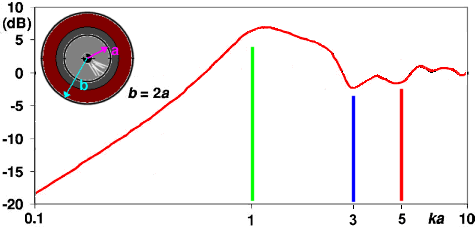
In your measurements dipole roll-off below 1kHz, dipole peak around 1,5kHz, first dipole null varying by width around 3kHz. The unequalized response follows the dipole theory quite well. Above 3kHz there is comb filtering/interferences that originate from dipole effect and vertical array effect. This summing leads to "smooth" spl response, but perhaps impulse and step response are not so smooth?
You can also download the English version pdf here Dipolplus - Alles über offene Schallwände

In your measurements dipole roll-off below 1kHz, dipole peak around 1,5kHz, first dipole null varying by width around 3kHz. The unequalized response follows the dipole theory quite well. Above 3kHz there is comb filtering/interferences that originate from dipole effect and vertical array effect. This summing leads to "smooth" spl response, but perhaps impulse and step response are not so smooth?
Allright, see your point. fyi: The off axis were done to the broader side.
But what about the different mic heights? Could an assymetric baffle be a factor contribute to that strange midrange I'm hearing? For instance, look at the "assymtric baffle on axis, different heights" - at mic pos 65cm there is a dip round 350Hz and 1500Hz which there is no at 105 and 160cm. I'm thinking since it's an array, the best characteristics would be if all the drivers operate under the same conditions. Now that would of course also differ in a rectangular baffle, but (according to some theories) as the array will act as one, tall driver, the sides are the most important here, aren't they? Wouldn't the sound from this "tall driver" be messed up if the distances to the sides are different everywhere?
But what about the different mic heights? Could an assymetric baffle be a factor contribute to that strange midrange I'm hearing? For instance, look at the "assymtric baffle on axis, different heights" - at mic pos 65cm there is a dip round 350Hz and 1500Hz which there is no at 105 and 160cm. I'm thinking since it's an array, the best characteristics would be if all the drivers operate under the same conditions. Now that would of course also differ in a rectangular baffle, but (according to some theories) as the array will act as one, tall driver, the sides are the most important here, aren't they? Wouldn't the sound from this "tall driver" be messed up if the distances to the sides are different everywhere?
- Home
- Loudspeakers
- Multi-Way
- Open baffle / dipole line array prototype
